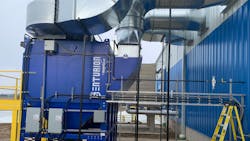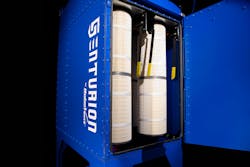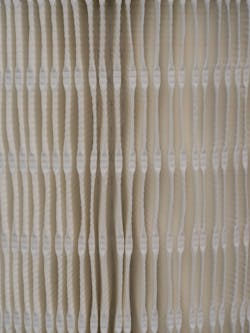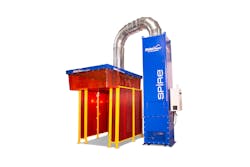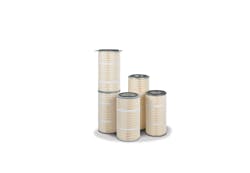Dust collection basics for powder and bulk solid applications
Powder and bulk solid materials can create several challenges for facilities when it comes to designing a dust control strategy. Depending on the type of material being processed, these challenges may include:
High dust volume. Many powder and bulk materials produce large volumes of dust, especially when moved, handled and processed.
Heavy or abrasive dust. Dust with heavy or abrasive properties can cause accelerated wear and tear on equipment, including filters, ductwork and fans.
Ultrafine dust. Ultrafine dust particles pose challenges for dust capture and filtration.
Sticky or hygroscopic dust. Dust that has adhesive or moisture-absorbing properties can cause filter clogging and buildup in ductwork and on equipment surfaces.
Toxic materials. When processing hazardous or toxic materials, stringent containment measures and regulatory compliance are necessary. The dust collection system must be designed to ensure compliance with exposure limits set by the Occupational Safety and Health Administration (OSHA) or other regulatory bodies.
Combustion risk. Most powder and bulk materials pose a risk of dust explosion, requiring special care in designing a dust control solution to ensure safety and compliance.
Application requirements. Specific industry or application requirements may dictate additional considerations, such as food-grade or pharmaceutical-grade construction materials, clean-room conditions in production environments, cross-contamination concerns, and compliance with relevant standards and regulations.
Dust collection system design considerations
Dust collection system designers must consider a number of important questions, including:
- What are the physical and chemical characteristics of the dust? (such as particle size distribution, morphology, reactivity, etc.)
- What is the hazard level of the dust? Are there permissible exposure levels (PELs) that must be met?
- Can dust-creating processes such as mixers, dump points, etc., be enclosed or otherwise contained?
- Is the dust combustible? If so, what is the dust’s ST class (a measure of how explosive the dust is)?
- How clean must the surrounding environment be? Is cross-contamination a concern? Does production require clean-room conditions?
- What are the space and layout constraints in the facility? Will a centralized dust collection system work, or will individual dust collectors be required for each production line or machine?
In addition, system designers may consider additional factors such as energy efficiency, sustainability and maintenance requirements when designing a dust control solution for powder and bulk applications.
Elements of dust control
A dust control strategy for a powder and bulk application will include containment and capture; dust collection and filtration; and housekeeping and administrative controls.
Containment and capture. Where possible, dust-producing processes should be contained to prevent dust from reaching other parts of the facility. A capture device, such as a hood or enclosure, should be used to enable efficient capture of airborne dust and powder at the source.
Dust collection and filtration. In almost all cases, an air filtration strategy is required to remove powdered contaminants from the air. Filtered air may be exhausted outside or returned to the facility.
Housekeeping and administrative controls. A dust control strategy also includes measures such as housekeeping (e.g., using HEPA-filtered vacuums or wet cleaning) to reduce dust buildup on surfaces, material handling techniques that minimize airborne dust, spill response and containment, and other administrative controls.
Selecting and sizing a dust collector
Choosing the right dust collector depends on the type and volume of the dust produced and the clean air goals for the facility. There are several types of dust collectors that can be used for powder and bulk applications.
Cartridge dust collectors use filter cartridges with pleated filter media. They are compact, easy to maintain, and suitable for handling a variety of dust types, from ultrafine to heavy and abrasive. Cartridge dust collectors are ideal for applications with limited space and moderate dust volumes.
Baghouse dust collectors use fabric filter bags to capture dust particles. These collectors are often used for applications requiring very high airflow and producing very large volumes of dust.
Cyclone dust collectors use centrifugal force to separate dust particles from the air stream. They are particularly effective for larger and heavier dust particles and can act as a pre-separator to protect filters in a secondary dust collector. However, they are not able to collect very fine particles or achieve the level of cleanliness required for most bulk and powder processing applications.
For the vast majority of powder and bulk applications, a cartridge collector provides the best solution. These collectors are highly versatile and can be sized and designed for a wide variety of dust types, airflow requirements and filtration efficiency demands. A cartridge dust collector must be sized appropriately for the volume of dust to be collected and the airflow required to collect it. The two important factors to consider in dust collector sizing are airflow and filter media surface area.
Airflow, measured in cubic feet per minute (CFM), is the amount of air the dust collector is able to move each minute. A system’s CFM requirements are determined by the size of the enclosure the dust collector must clean and the air velocities required for efficient dust capture.
Filter media surface area, generally measured in square feet, is the total surface area for all filters in the dust collector. The ratio of CFM to filter media surface area is known as the air-to-cloth ratio or filter velocity.1 Applications producing higher volumes of particulates will require more filter media per CFM.
Dust capture and containment
For most powder and bulk applications, a source capture solution is preferred. In a source capture system, airborne contaminants are collected as close to their source as possible. This reduces the volume of air the dust collector must move to capture contaminants and prevents dust from migrating into other areas of the facility, minimizing cross-contamination and worker exposure concerns.
For powder and bulk applications, dust-producing processes include material receiving and unloading, conveying and material transfer, mixing and blending, grinding/milling/crushing, screening/sieving, weighing and batching, and filling and packaging. Applications that produce or disturb dust should be enclosed or contained where possible using one of several types of dust collection hoods.
An enclosing hood fully encloses the application. These hoods are preferred where it is possible to fully contain a powder and bulk process.
A close capture hood is positioned to capture dust as it is produced. These hoods may be effective in removing a majority of dust produced at dump or transfer points, for example, where full enclosure may not be feasible.
A receiving hood is positioned above the application to pull contaminants up and out. Receiving hoods are typically used for fumes produced by thermal processes, which rise naturally, but may not be effective for most powder and bulk applications.
Hood design is an important consideration for dust collection system efficiency and effectiveness. The hood or enclosure should be designed to both minimize the volume of air the dust collector must move (which will, in turn, reduce the system’s energy consumption) and maximize the dust capture rates.
In addition to hood design, it is important to consider capture velocity requirements for the applications. In general, heavier dust will require higher air velocities than lighter dust for effective capture.
Filtration strategy
Choosing the right filters is essential to ensure a dust collection system’s effectiveness. Filter selection depends on the type and volume of dust being collected. The right filters will provide the optimal level of filtration efficiency to meet clean air requirements and use a filter media suitable to the application to improve performance and filter life.
Filtration efficiency
Cartridge filters are rated using the Minimum Efficiency Reporting Value (MERV) rating system, as determined by ASHRAE Standard 52.2.2 The rating is based on the filter's ability to capture particles between 0.3 and 10 microns in size. A higher MERV rating indicates that the filter is better able to capture smaller particles. Typical cartridge filters will have a MERV rating between 11 and 16. Choose a filter with a MERV rating appropriate for the smallest size particle you need to capture and the level of capture efficiency needed to meet the PEL or application requirements. Dust collectors are also rated by ASHRAE Standard 199, which tests how well they perform in real-world conditions.3
For ultrafine dust in the submicron range, a HEPA after-filter may be recommended to remove the smallest particles efficiently, especially if cleanroom or near-cleanroom conditions are required.
Filter media types and coatings
Cartridge filters also come in a variety of materials and with specialized coatings for different types of dust. In addition to the MERV rating, pay attention to filter media type and coatings for best performance. Common filter types include:
Cellulose. Cellulose filter media is made from wood pulp and is suitable for a wide range of general dust collection applications. Cellulose media offers good filtration efficiency and a relatively low cost. However, it may not be ideal for high-moisture or high-temperature environments.
Synthetic blends. Synthetic blend filter media combine cellulose with synthetic fibers, such as polyester, to improve strength, durability, and moisture resistance. Synthetic blend filters can handle a broader range of dust types and operating conditions than cellulose filters.
Spunbond polyester. Spunbond polyester filters provide excellent strength, durability, and moisture resistance. They are suitable for challenging applications involving abrasive dust or high humidity and can also support higher temperatures than cellulose or synthetic blend media (about 40-50°F higher).4
Meltblown polyester. Meltblown polyester filters use finer fibers than spunbond polyester filters, resulting in improved filtration efficiency. These filters also offer good resistance to moisture and temperature.
PTFE membrane. PTFE (polytetrafluoroethylene) membrane filters feature a thin layer of PTFE on the surface of the filter media. The PTFE membrane provides excellent filtration efficiency, non-stick properties and resistance to chemicals, making them ideal for sticky, hygroscopic or chemically reactive dust.
Antistatic filters. Antistatic filters contain conductive or static-dissipative fibers, such as carbon or stainless steel, to help dissipate electrostatic charges. Antistatic filters are suitable for dust collection applications involving high-static or combustible dust.
Nanofiber filters. Nanofiber filters use ultrafine fibers layered on the surface of the filter media. These filters offer high filtration efficiency, low pressure drop and good dust release properties, making them ideal for capturing fine or ultrafine dust particles.
Progressive filtration
Progressive filtration involves using multiple stages of filtration, with each stage designed to capture a specific range of particle sizes or types. For example, a prefilter may be used to capture coarse dust, followed by a MERV-rated cartridge filter, and finally, a HEPA after-filter. A progressive filtration strategy may be recommended for powder and bulk applications with a lot of variability in particle size distribution and high capture efficiency requirements. This approach can help reduce the load on the final filter stage, minimize filter clogging and prolong the service life of the filters.
Filter protection
The dust collection system should also have elements to protect the filters and extend their life. Most cartridge dust collectors have a filter pulsing mechanism to pulse excess dust off the filters and shake it down into the collection bin. Properly timed and controlled pulsing can prevent excessive dust buildup, reduce filter clogging and maintain a low pressure drop across the filters.
For heavy, abrasive dust, additional filter protection methods may be needed, such as the use of baffles to prevent the heaviest particles from hitting the filters directly. Drop-out boxes can also be used to allow the heaviest material to fall out of the airstream before hitting the filter cabinet. These methods reduce wear on filters to prevent tears and leaks and extend filter life.
Safety and compliance
Dust collector fire and explosion safety is a critical concern in powder and bulk processing applications, as combustible dust can pose significant risks to personnel, equipment and facilities. Ensuring compliance with the National Fire Protection Association (NFPA) standards can help mitigate these risks and maintain a safe working environment.
Depending on the characteristics of the dust, the application may require:
Fire suppression. A fire suppression system may be a water sprinkler system, CO2 or clean agent gas system.
Deflagration protection. An NFPA-compliant deflagration system reduces the impact of an explosion inside the dust collector. The system may include explosion venting, an isolation valve to prevent a pressure wave from propagating back into the building and rotary airlocks to prevent dust from escaping from the collection bin.
Wear-resistant coatings and linings
Applying wear-resistant coatings or linings to the interior surfaces of dust collectors and ductwork can significantly extend their service life by providing a protective barrier against abrasive dust particles. These may be recommended when collecting highly abrasive dust. Common materials used for these coatings and linings include ceramic, epoxy or metal-based compounds, which are known for their durability and resistance to abrasion. These materials can be applied as a spray-on coating or installed as a pre-fabricated lining, depending on the system’s specific requirements.
Ductwork design
To minimize wear in ductwork, it is important to design the duct system with appropriate sizing, layout and air velocities. This helps ensure efficient dust transport and minimizes the chance of dust settling or accumulating within the ducts, which could lead to increased abrasion and wear over time. A streamlined layout that minimizes turns and elbows will provide the best energy efficiency and performance.
It is also important to ensure that the interior surfaces of the dust collector and ductwork are as smooth as possible. This can help reduce the accumulation of dust on the surfaces and minimize friction between the dust particles and the interior walls, further improving efficiency. Smooth surfaces also facilitate easier cleaning and maintenance of the system.
Putting it all together
Designing and engineering an effective dust collection system for powder and bulk processing applications requires a comprehensive understanding of the unique challenges and requirements presented by these materials. It is usually best to contract with an experienced dust collection engineering firm that can help analyze the dust, evaluate the current state of the facility and engineer a solution that will meet your requirements for air quality, ensure compliance with all relevant regulations, and optimize the system for energy efficiency and performance. An effective dust control system for powder and bulk applications is an important investment in worker health and safety, product quality and equipment life and performance for process manufacturers.
References
2. https://www.ashrae.org/File%20Library/Technical%20Resources/COVID-19/52_2_2017_COVID-19_20200401.pdf
4. Note that for high-temperature applications, in addition to the filter media, you will also need to consider the temperature limitations of seals, gaskets, diaphragm valves and other dust collector components to ensure that the system is suitable for the temperature range.
Jacques Kregting is a senior application engineer for RoboVent, a leading provider of dust collection and air filtration solutions for manufacturing, including powder and bulk, welding and metalworking and other industrial applications. He brings 20 years of experience in the air filtration industry, designing custom solutions for a wide variety of dust collection scenarios.
RoboVent
About the Author
Jacques Kregting
Senior application engineer at RoboVent
Jacques Kregting is a senior application engineer for RoboVent, a leading provider of dust collection and air filtration solutions for manufacturing, including powder and bulk, welding and metalworking and other industrial applications. He brings 20 years of experience in the air filtration industry, designing custom solutions for a wide variety of dust collection scenarios.
